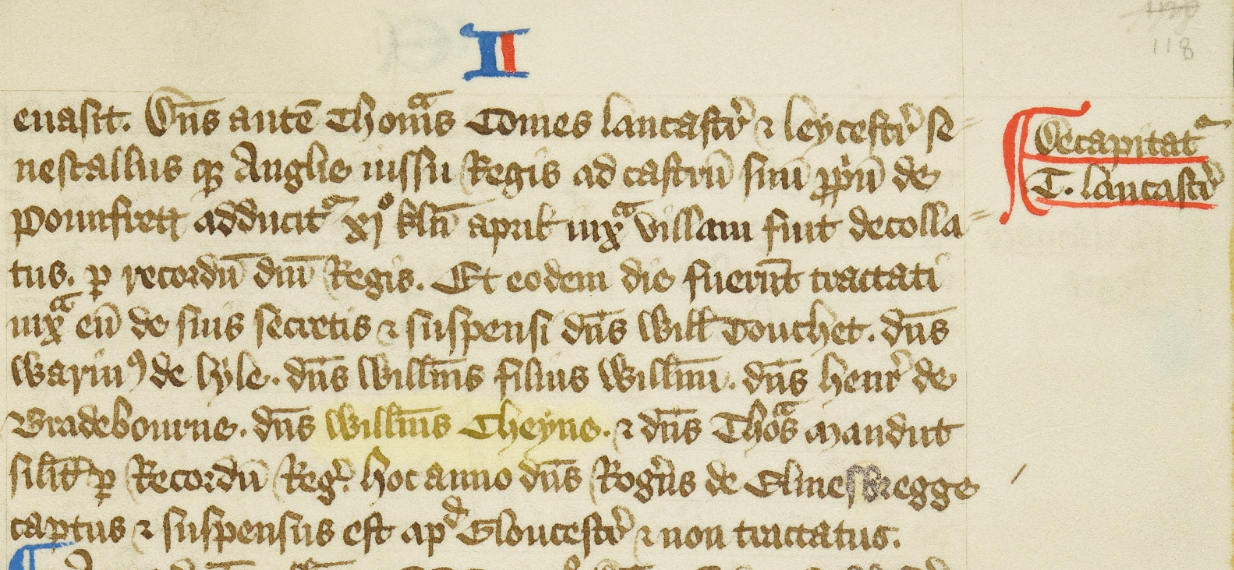- map
- how you can help
- FAQ's
- contact
- copyright
-
ahnentafel and citation # display:| |

| Snapshot: | tortured to death for rebelling against King Edward II |
| Parents: | 8406496Alexander de Cheyne 8406497Agnes de Say |
| Born: | circa 1274 location unknown |
| Died: | not long after 22 March 1322 perhaps York, England |
| Buried: | unknown |
His father had died by May 1296, and
He married 4203249Margaret Shurland,
Douglas Richardson's Royal Ancestry, which is generally recognized as a reliable reference work, states that

In 1316
In 1322
We know that
The rebel leader was executed a few days after the battle, and other high-ranking rebels were also executed soon thereafter, including
[Numerous other rebels] et Willelmus Cheyne, qui capti sunt cum Thoma Comite, propter roberias et felonias, et resistentiam quam fecerunt contra Regem ad villam de Burtone, occidentes Regis familiares, et Regis transitum prohibentes, ac partem villæ prædictæ in recesssu suo comburentes, cæteraque perpetrantes, quæ dicto Thomæ Comiti imponuntur, adjudicati sunt, de prædictorum Comitum et Baronum consilio, tractioni et suspensioni apud Eboracum.Translation: "[Numerous other rebels] and William Cheyne, who were captured with Earl Thomas, on account of robberies and felonies, and the resistance which they committed against the King at the town of Burton, killing the King's family members, and forbidding the King's passing, and burning a part of the aforesaid village during their retreat, and committing those things which are imposed on the said Earl Thomas, were adjudged, on the advice of the aforesaid Earls and Barons, to be drawn and hung at York."
A parliamentary writ includes "Sire William Cheyne" on a list of men who were treynez ⁊ penduz ("hung and drawn") in the wake of the failed rebellion.

On the back of a document pertaining to the rebellion, someone apparently wrote a brief description of l frettee dor label dargent."
|
Online genealogies that include 9. WILLIAM DE CHEYNE (or CHEYNEY), of Streat, Sussex, and Patrixbourne, Kent, son and heir, born about 1274 (aged 22 in 1296). He married MARGARET DE SHURLAND (or SHIRLAND), daughter of Robert de Shurland, Knt., of Shurland (in Eastchurch), Isle of Sheppey, Kent, by his wife, Margery. They had three sons, William, Robert, Knt., and Peter. His wife, Margaret, was co-heiress to her brother, Robert de Shurland, and sole heiress to her sister, Maud de Shurland. He served in France and also against the Scots under King Edward I. In 1316 he was pardoned a debt of 102s. 1-¼d. in consideration of the good service done by his late father, Alexander de Cheyne, to King Edward I in Gascony. He opposed Peter de Gaveston, and then Hugh le Despenser, and fought at the Battle of Boroughbridge against the King's forces in March 1322. WILLIAM DE CHEYNE is said to have been hanged at York or Pontrefract following the battle.Hasted Hist. & Top. Survey of Kent 6 (1798): 246-249; 9 (1800): 279. Clutterbuck Hist. & Antiqs. of Hertford 1 (1815): 133 (Cheyney ped.). Sussex Arch. Colls. 25 (1873): 108-111 (Cheyney ped.); 65 (1924): 20-53. Arch. Cantiana 14 (1882): 169-170; 20 (1893): 173, 178, 179, 186; 21 (1895): 205, 210-211 (re Shurland). C.C.R. 1313-1318 (1893); 377. Benolte et al. Four Vis. of Berkshire 1532, 1566, 1623 & 1665-6 2 (H.S.P. 57) (1908): 102-105 (Cheney ped.: "W Richardson's citation of Archaeologia Cantiana, volume 20 (1893), pages 173 (entry #171) and 178-179 (entries #201 and #205) could lead to confusion, since these records actually refer to |
1: Rotulorum Originalium in Curia Scaccarii Abbreviatio, Volume I (1805), page 96.
2: Calendar of Inquisitions Post Mortem and Other Analogous Documents Preserved in the Public Record Office, Volume VII, Edward III (London, 1909), page 416. The key phrases are "moiety was sometime in the hand of William de Say;" "the said William [de Say] [...] gave the said moiety [...] to Alexander de Cheyny [...] and to Agnes his wife;" and "William de Cheyny, son of the said Alexander and Agnes."
3: Calendar of Inquisitions Post Mortem and Other Analogous Documents Preserved in the Public Record Office, Volume III, Edward I (London, 1912), page 205-6.
4: Calendar of the Close Rolls Preserved in the Public Record Office, Edward II, 1313-1318, page 377.
5: Records of the Barony and Honour of the Rape of Lewes (Sussex Record Society, Volume 44) (1939), pages 78-79.
6: Calendar of Inquisitions Post Mortem and Other Analogous Documents Preserved in the Public Record Office, Volume VII, Edward III (London, 1909), page 416.
7: Douglas Richardson, Royal Ancestry: A Study in Colonial and Medieval Families, Volume IV, page 459.
8: Thomæ Walsingham, Historia Anglicana, Volume I, page 165. The text is apparently a transcription of part of Royal MS 13 E ix.
9: Francis Palgrave, Parliamentary Writs and Writs of Military Summons [...], Volume II, Division II (1830), appendix page 201.
10: Trinity College Cambridge manuscript R.5 41, folio 118
11: Francis Palgrave, Parliamentary Writs and Writs of Military Summons [...], Volume II (1830), page 199.